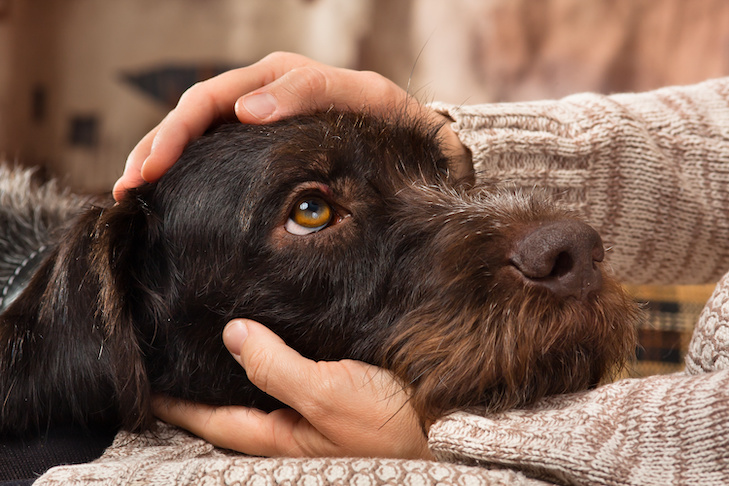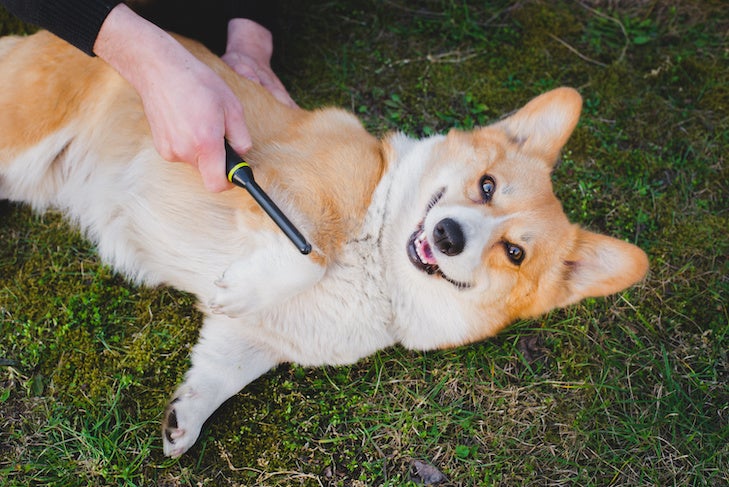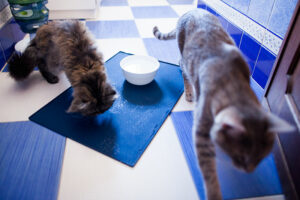Many people see grooming your dog as a necessary evil that’s not particularly fun. Unfortunately, many dogs feel the same way and are often afraid or uncomfortable with being groomed. You might notice your dog hates beign groomed. But by shifting your approach to grooming, you can make it an activity that your dog actively participates in — and even enjoys. Husbandry training is a collaborative approach that will make grooming more enjoyable and less stressful for you and your dog.
What Is Husbandry Training?
Husbandry training is a broad category that includes the ways that we care for, groom, and otherwise maintain our dogs so that they live a healthy life. It includes everything from grooming, brushing your dog’s teeth, and trimming your dog’s nails to preparing for standard vet procedures like blood work and getting canine vaccinations.
Husbandry training often occurs in zoo settings. Zookeepers use positive reinforcement to teach animals, including large predators, to be active participants in their care. Using cues, keepers and veterinarians can assess an animal’s health and provide veterinary care without needing to restrain or sedate the animal. The goal is the same for your dog at home: to help them be active participants in their own grooming.
Get Your Dog Used to Your Hands
Even if your dog hates being groomed, it’s important to get them comfortable with you touching them. As soon as you bring home a puppy, start handling all parts of their body from their toes to their ears and tail. The younger your puppy is when you start this, the easier it will be.

You can also teach adult dogs these skills. Start by touching them slowly in places you know they’re comfortable with and then pet, praise, and treat your dog. As your dog grows more accustomed to it, you can move onto more sensitive areas. Be sure to keep your movements fluid and calm, praising and treating your dog for calm behavior. Also, keep training sessions short, focusing on some parts of the body rather than the entire body. You don’t need to cover all areas of your dog’s body in one session.
Teach Your Dog to Do Their Own Nails
One way you can give your dog choices while grooming is to teach them to trim their own nails. By teaching your dog to scratch a sandpaper board (similar to a person using a nail file), they’ll be able to scratch their own nails down. This can reduce how frequently you’ll need to trim their nails. This can be particularly helpful in the short term for foot-sensitive dogs.
Here’s how to get started:
- If your dog doesn’t already know how to shake hands, you’ll want to start by teaching that trick.
- Show your dog the sandpaper or scratchboard you’ve created. Praise and give your dog a treat when they interact with the board, including sniffing or approaching it.
- Next, hold the scratchboard out to your dog and give your shake cue. When your dog’s paws hit the board, praise and treat.
- Repeat while alternating the paw your dog is using to scratch on the board.
Simulate Medication Delivery
Even if you only need to administer your dog’s flea and tick medication once a month, you can incorporate planning for it into your dog’s daily training. This will increase your dog’s comfort with the procedure and reduce stress when you actually have to give medication. To do this, start by teaching a chin rest:
- Put your hand under your dog’s chin and praise and treat when your dog’s chin touches your hand.
- After several repetitions, you can start to incorporate a verbal cue of your choice, such as “chin” or “rest.”
- Start with your hand a couple of inches away from your dog’s chin, then use your verbal cue. When your dog’s chin touches your outstretched hand, offer lots of praise and treats.
- After several more practice sessions, you can start to alter the criteria. Very slowly, you can increase the amount of time your dog holds the position before you praise and treat.

As your dog gets more comfortable and familiar with the skill, you can begin to create scenarios that mimic giving your dog topical medication. Instead of using the medication when training, you can take a cotton swab or a plastic syringe filled with water (and without a needle).
- Start by just touching the back of the neck or other area where you administer medication. This will get get your dog used to the sensation. Praise and treat.
- After several sessions, you can use your cotton swab or plastic syringe to gently touch the back of your dog’s neck. Offer lots of praise and treats.
Give Your Dog Choices
One of the best things about dog training is teaching dogs to make choices in their lives. Using husbandry training for grooming can open up new layers of communication between you and your dog, especially if the dog hates being groomed. You control so many things about your dog’s day — when they walk, what they eat, and more — so it’s nice to give them a choice when you can.
One way to give your dog agency is to make grooming a highly rewarding activity but also allow them to opt in and out of it. This can work for brushing, nail trimming, and even in the bath. Here’s how to do it:
- Find a spreadable and soft high-value treat like dog-safe peanut butter or spray cheese. Spread it onto a plate or silicone baking sheet or plate (You can also purchase dog-specific lick mats for this purpose).
- Set up your dog grooming supplies on the floor. Alternatively, you can put them in an area that your dog can easily get on and off of, like a couch.
- Give your dog the plate or mat covered in treats and begin grooming, offering them lots of praise.
- If at any point your dog wanders away, that’s completely fine — don’t try to chase them or convince them to come back. The idea is to build an understanding with your dog that they can choose to opt in or opt out of grooming.
- When your dog returns and is interested in the high-value and lickable treats, resume the grooming with lots of calm praise.
With this method, your dog is then deciding to stay and participate in grooming. They can choose to end the grooming session at any point, but if they leave, the high-value reward is no longer accessible. This helps make grooming a rewarding activity that your dog can choose to participate in rather than an unpleasant experience to avoid.







